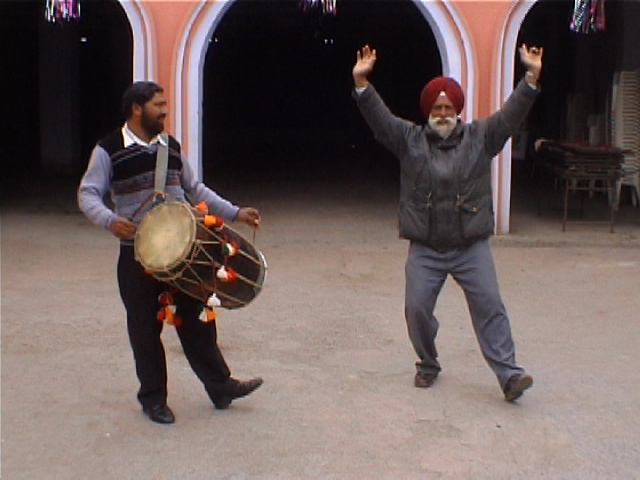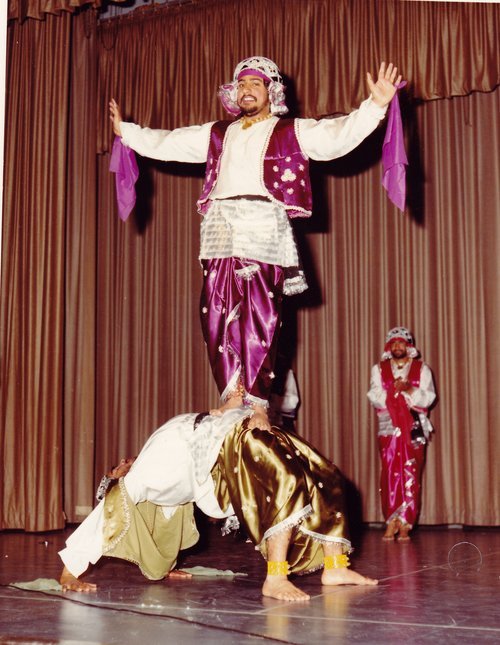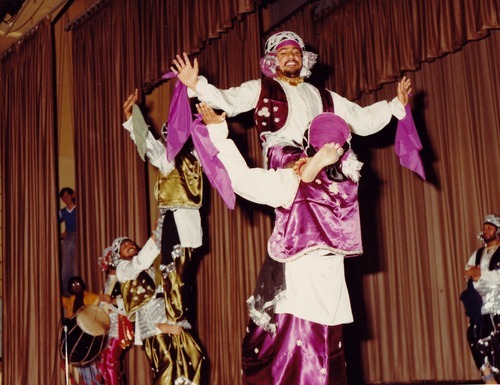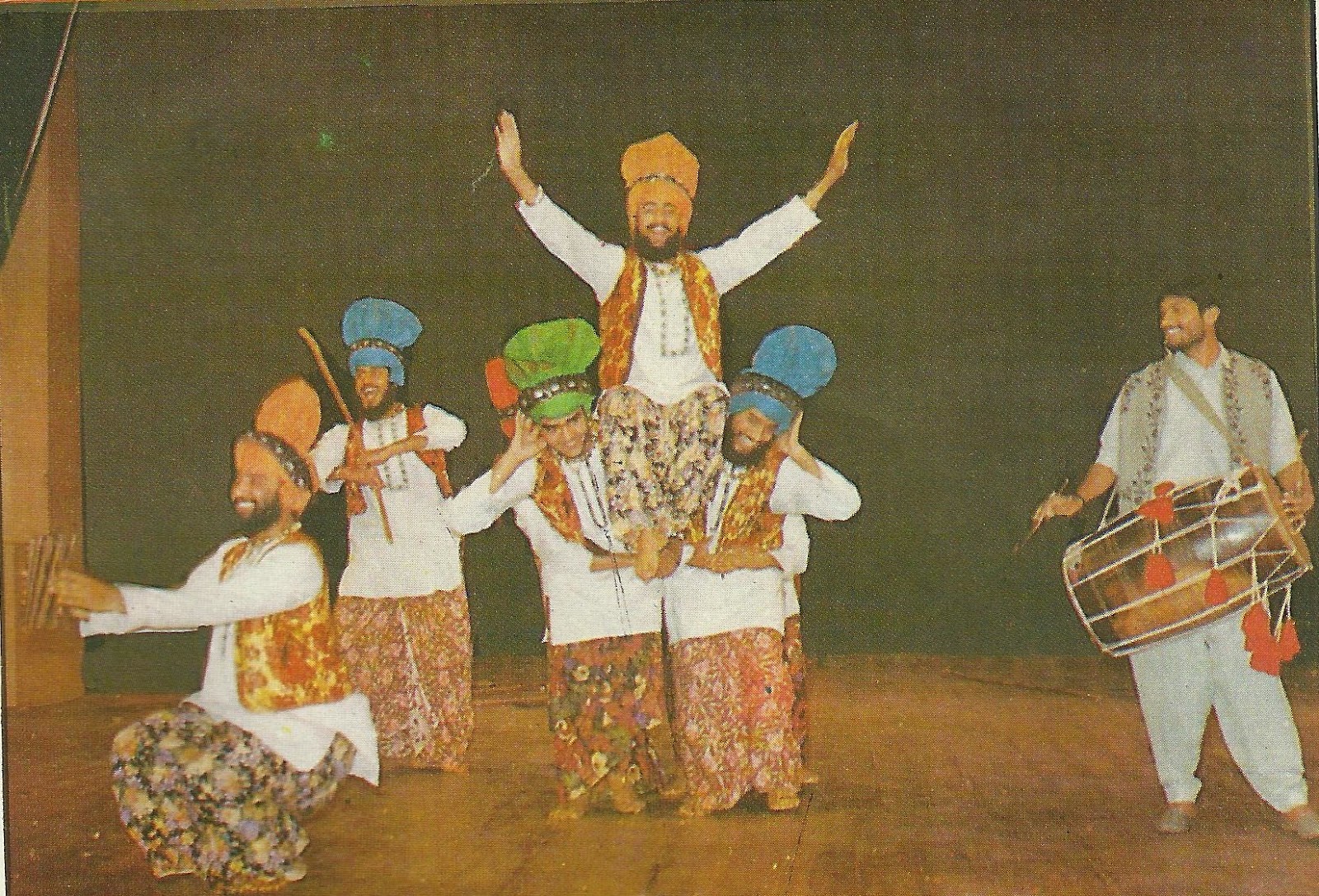Gabbah Shareef Bhalwan
Member
- Messages
- 237
1960s - intro and photos
I don't have much in the way of 1960s photos, unfortunately. In the 1950s, the PEPSU troupe was a big deal, so there were a lot more photos and documentation. 1960s bhangra was taken for granted a bit more, I think. If one (one with some time!) were to sift through some 1960s Punjabi movies, I'm sure s/he would find some interesting stuff. Anyone have photos?
In any case, to contextualize the 1960s:
I consider this a new era of bhangra. PEPSU troupe as such had left the picture. Starting from the year 1960, and extending at least into the late 1970s continually (story varies), Master Harbhajan Singh was leading the bhangra groups that went to Republic Day and some other events. (I don't have any 1960s photos of Harbhajan Singh; I have 1970s photos, but unfortunately I cannot post them at this time.) In lieu of photos of Master Harbhajan Singh, I'll just link to this video -- which I know has been posted to BTF a couple times already, but it is useful to have here. And I know it is from a recent event BUT seeing Harbhajan Singh dance in his style would, presumably, give some idea of what he was doing/coaching in the 1960s-70s.
punjabi baba bhangra jatt babu maan gippy must watch
The import of Harbhajan Singh taking over the lead at Republic Day is this. The PEPSU guys, as discussed, were not from bhangra areas. And they were coached by skilled Bazigars that, nonetheless, were not advocating a "pure" bhangra, but rather just men's dance from the areas they'd traveled in and which looked good and was entertaining. The PEPSU group almost immediately inspired many others to create bhangra groups, after their 1954 Republic Day appearance. Dholi Garib Dass, for instance, was playing for a bhangra team in Chandigarh area already in 1955. And many lads had been recruited and trained to go along with the Deepak group to fill out the ranks at Republic Days.
Other groups meant other interpretations. Remember that the name and concept of "bhangra" had been applied to the routine in 1954, so others would be thinking along the lines of doing stuff that specifically represented, whether accurately or imagined, the village bhangra.
Harbhajan Singh, b. 1938, emigrated at Partition while just a boy. But the people from his area were not displaced very far. He'd been born in the subdistrict Shakargarh, which was part of district Gurdaspur before Partition. Partition split district Gurdaspur; Shakargarh ended up on the Pakistani side. Harbhajan Singh resettled in Khokhar Faujian village on the Indian side, not far from Batala. Others settled in his village that had some sense of village bhangra. (Note: parts of Gurdaspur district and Jammu are the only Indian districts considered to have been in the historic village bhangra area.) So he had some sense of village bhangra style.
As leader of the Punjab state bhangra team, my sense is that he would have reformed it somewhat, introducing movements he knew, and, perhaps, eliminating some that seemed too out of place. The style of dancing would have changed, too. I don't mean it as negative criticism (just observing) when I say that Harbhajan's style was maybe a bit harder, more angular and rigid, as compared to the PEPSU troupe's softer, more flowing and loose style. Again, please understand that I am not saying Harbhajan Singh and his trainees do or ever did dance in a way that was "too rigid" ore whatever -- I am just speaking relatively. I think part of it is explained by the fact that dances of the southern parts of Punjab (where the PEPSU people had come from) just tend to by "softer" whereas the northern, bhangra area was "harder."
We see, perhaps, that in Harbhajan Singh's 1960s area, so of the "nonsense" disappeared. No more Bazigars playing the multiple instruments. No acrobatics. More straightforward formations as opposed to guys doing individual actions.
But whatever Harbhajan Singh did to insert village bhangra actions and/or style into the folkloric (staged) dance -- and I think he did do stuff -- he had to do it within a paradigm that had already been formed. The mixed and staged routine had certain conventions, expectations, and a history of several years of many people doing it, so it could not be turned into a "pure" replica of village bhangra.
As an illustrative example, here is a photo I took of Harbhajan Singh demonstrating his version of the "jhummar" step in the bhangra routine. Harbhajan Singh was absolutely clear that jhummar did not exist in the area that he grew up in. Yet we also see that the PEPSU group, even though those guys were pros at jhummar (supposedly they even brought jhummar to Republic Day very early on, and it was the more dominant dance of their home areas), had not put anything (at least not anything I recognize) of jhummar in their bhangra. So it seems that jhummar step was added on Harbhajan's watch. And it is a rather "generic" jhummar step; it's style (not to criticize negatively) lacks finesse of actual jhummar. BTW, I believe this jhummar step was added into the bhangra routine in 1961. That's the year that Pokhar Singh's group did a big jhummar at Republic Day.
So to repeat, though Harbhajan's influence was to bring the stage dance back in line with some "authentic" village bhangra style, the dance would still develop as a form into which one added steps from various places. Here's the photo, from 2005.

More photos (to be added to as more come in):
This is dholi Lal Singh (née Lal Chand) Bhatti (3rd from left, standing) with a group. My best idea is that it is Khalas College, Jalandhar, but please someone correct. And I'm posting it here because it looks to be 1960s. From lalsinghbhatti.com.

When Harbhajan Singh started his run at Republic Day in 1960, he took dancers from several college groups. DAV College Jalandhar was one of them, but Khalsa College, as far as I know, was not. I don't know exactly when Khalsa College Jalandhar people would have started doing the Republic Day thing. I'm guessing this is a few years before Lal Singh got involved.
I don't have much in the way of 1960s photos, unfortunately. In the 1950s, the PEPSU troupe was a big deal, so there were a lot more photos and documentation. 1960s bhangra was taken for granted a bit more, I think. If one (one with some time!) were to sift through some 1960s Punjabi movies, I'm sure s/he would find some interesting stuff. Anyone have photos?
In any case, to contextualize the 1960s:
I consider this a new era of bhangra. PEPSU troupe as such had left the picture. Starting from the year 1960, and extending at least into the late 1970s continually (story varies), Master Harbhajan Singh was leading the bhangra groups that went to Republic Day and some other events. (I don't have any 1960s photos of Harbhajan Singh; I have 1970s photos, but unfortunately I cannot post them at this time.) In lieu of photos of Master Harbhajan Singh, I'll just link to this video -- which I know has been posted to BTF a couple times already, but it is useful to have here. And I know it is from a recent event BUT seeing Harbhajan Singh dance in his style would, presumably, give some idea of what he was doing/coaching in the 1960s-70s.
punjabi baba bhangra jatt babu maan gippy must watch
The import of Harbhajan Singh taking over the lead at Republic Day is this. The PEPSU guys, as discussed, were not from bhangra areas. And they were coached by skilled Bazigars that, nonetheless, were not advocating a "pure" bhangra, but rather just men's dance from the areas they'd traveled in and which looked good and was entertaining. The PEPSU group almost immediately inspired many others to create bhangra groups, after their 1954 Republic Day appearance. Dholi Garib Dass, for instance, was playing for a bhangra team in Chandigarh area already in 1955. And many lads had been recruited and trained to go along with the Deepak group to fill out the ranks at Republic Days.
Other groups meant other interpretations. Remember that the name and concept of "bhangra" had been applied to the routine in 1954, so others would be thinking along the lines of doing stuff that specifically represented, whether accurately or imagined, the village bhangra.
Harbhajan Singh, b. 1938, emigrated at Partition while just a boy. But the people from his area were not displaced very far. He'd been born in the subdistrict Shakargarh, which was part of district Gurdaspur before Partition. Partition split district Gurdaspur; Shakargarh ended up on the Pakistani side. Harbhajan Singh resettled in Khokhar Faujian village on the Indian side, not far from Batala. Others settled in his village that had some sense of village bhangra. (Note: parts of Gurdaspur district and Jammu are the only Indian districts considered to have been in the historic village bhangra area.) So he had some sense of village bhangra style.
As leader of the Punjab state bhangra team, my sense is that he would have reformed it somewhat, introducing movements he knew, and, perhaps, eliminating some that seemed too out of place. The style of dancing would have changed, too. I don't mean it as negative criticism (just observing) when I say that Harbhajan's style was maybe a bit harder, more angular and rigid, as compared to the PEPSU troupe's softer, more flowing and loose style. Again, please understand that I am not saying Harbhajan Singh and his trainees do or ever did dance in a way that was "too rigid" ore whatever -- I am just speaking relatively. I think part of it is explained by the fact that dances of the southern parts of Punjab (where the PEPSU people had come from) just tend to by "softer" whereas the northern, bhangra area was "harder."
We see, perhaps, that in Harbhajan Singh's 1960s area, so of the "nonsense" disappeared. No more Bazigars playing the multiple instruments. No acrobatics. More straightforward formations as opposed to guys doing individual actions.
But whatever Harbhajan Singh did to insert village bhangra actions and/or style into the folkloric (staged) dance -- and I think he did do stuff -- he had to do it within a paradigm that had already been formed. The mixed and staged routine had certain conventions, expectations, and a history of several years of many people doing it, so it could not be turned into a "pure" replica of village bhangra.
As an illustrative example, here is a photo I took of Harbhajan Singh demonstrating his version of the "jhummar" step in the bhangra routine. Harbhajan Singh was absolutely clear that jhummar did not exist in the area that he grew up in. Yet we also see that the PEPSU group, even though those guys were pros at jhummar (supposedly they even brought jhummar to Republic Day very early on, and it was the more dominant dance of their home areas), had not put anything (at least not anything I recognize) of jhummar in their bhangra. So it seems that jhummar step was added on Harbhajan's watch. And it is a rather "generic" jhummar step; it's style (not to criticize negatively) lacks finesse of actual jhummar. BTW, I believe this jhummar step was added into the bhangra routine in 1961. That's the year that Pokhar Singh's group did a big jhummar at Republic Day.
So to repeat, though Harbhajan's influence was to bring the stage dance back in line with some "authentic" village bhangra style, the dance would still develop as a form into which one added steps from various places. Here's the photo, from 2005.

More photos (to be added to as more come in):
This is dholi Lal Singh (née Lal Chand) Bhatti (3rd from left, standing) with a group. My best idea is that it is Khalas College, Jalandhar, but please someone correct. And I'm posting it here because it looks to be 1960s. From lalsinghbhatti.com.

When Harbhajan Singh started his run at Republic Day in 1960, he took dancers from several college groups. DAV College Jalandhar was one of them, but Khalsa College, as far as I know, was not. I don't know exactly when Khalsa College Jalandhar people would have started doing the Republic Day thing. I'm guessing this is a few years before Lal Singh got involved.


























